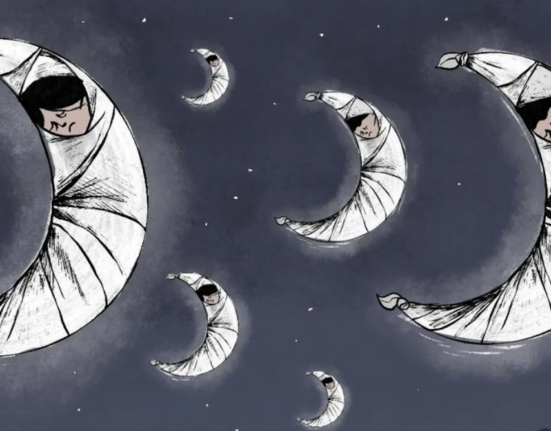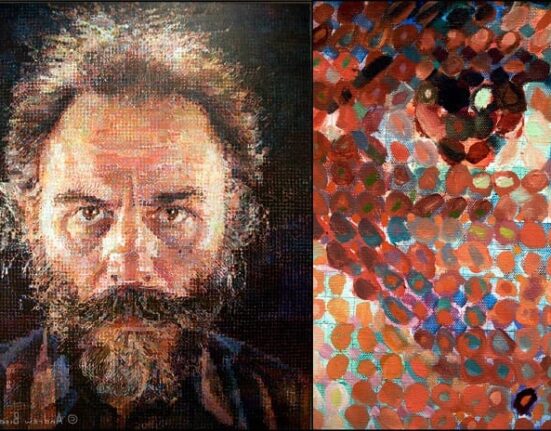Alexis Smith may have spent her working life in Los Angeles, but the conceptual and collage artist who passed away Tuesday at her home in L.A. also left an indelible mark in San Diego.
Smith, who was 74 when she died following an eight-year battle with Alzheimer’s disease, leaves behind two public art pieces in the Stuart Collection at UC San Diego: “Snake Path” and “Same Old Paradise.”
Created in 1992, “Snake Path” is a winding, 560-foot walkway near UCSD’s Geisel Library shaped like a serpent and decorated with hexagonal “scales” of colored slate. “Same Old Paradise” is a 22-by-62-foot mural/collage depicting California mountains and orange groves. Originally created for a Brooklyn museum in 1987, it was donated to UCSD in 2018 and finally installed in the Jeannie Lecture Hall in 2021.

Alexis Smith’s “Same Old Paradise” mural in the Jeannie Lecture Hall at UC San Diego in La Jolla.
(Philipp Scholz Rittermann)
Smith was also the subject of a 50-year retrospective at the Museum of Contemporary Art San Diego (MCASD) in 2022. “Alexis Smith: The American Way” featured 50 collages, assemblages and other works from the 1970s-2010s. It was the most comprehensive exhibition of the artist’s work since her 1991 survey at the Whitney Museum of American Art in New York.
Kathryn Kanjo, director and CEO of MCASD, said she and her staff were “immensely saddened” to learn of Smith’s death this week.
“With a sharp eye and biting wit, Alexis Smith plumbed the social mores of American culture in the 20th century,” Kanjo wrote, in an email. “Using the materials and language of the era, her appealing collages and sculptures took the shape of the scripts, signs, and scenarios they referenced. Informed by the legacies of Conceptualism and Pop art, her work emerged coincident with the feminist movement of the 1970s. Referencing themes of self-invention and change, her work likewise evolved from intimate artist books and performance, to wall-bound sculpture and large public works. Smith resisted easy categorization, even as she cemented her importance in the contemporary art scene, especially in Southern California. Her distilled humor shared space with artist peers John Baldessari and Ed Ruscha, while her storytelling connects with artists such as Barbara T. Smith.”

Installation view of “Alexis Smith: The American Way,” the L.A. artist’s 50-year retrospective at Museum of Contemporary Art San Diego in 2022.
(Philipp Scholz Rittermann)
Smith was known for innovative collages in unique or exotic frames, which paired found objects with backgrounds such as maps, vintage magazine covers and amateur paintings, according to a biography of the artist by the UCSD Stuart Collection.
She combined fragments from the mass media like magazine covers or dust jackets of the 1940s with a wide range of kitsch and found objects. Often, she organized several collages into sequences, implying a coherent narrative. As in a film, related fragments of text (almost a “soundtrack”) link one collage to another.
Smith also painted large motifs directly onto a gallery’s walls and then hung her smaller framed works on this mural-like background to create a college, as in the “Same Old Paradise” at UCSD. Smith also created environmental art and large-scale installations, like the terrazzo floors at both the Los Angeles Convention Center and the Schottenstein Sports Arena at Ohio State University.

Artist Alexis Smith’s Stuart Collection work “Snake Path” is a winding 560-foot-long, 10-foot-wide footpath in the form of a serpent.
(Philipp Scholz Rittermann)
MCASD first exhibited Smith’s work in a 1975 group exhibition of pieces by artists from UC Irvine, where she enrolled at age 17 and graduated in 1970. Three years later, Smith was featured in an MCASD group exhibition of “Southern California Styles” of the ‘60s and ‘70s. MCASD now holds in its collection 11 works from different phases of Smith’s career.
Speaking in an interview years ago, Smith said her artwork was “about the normal things that have to do with the experience of 20th-century existence and a separate subtext of looking for meaning in life. You have to read into each piece for yourself; there is no correct interpretation, no right answer. The art is something that happens in your head.”
pam.kragen@sduniontribune.com






